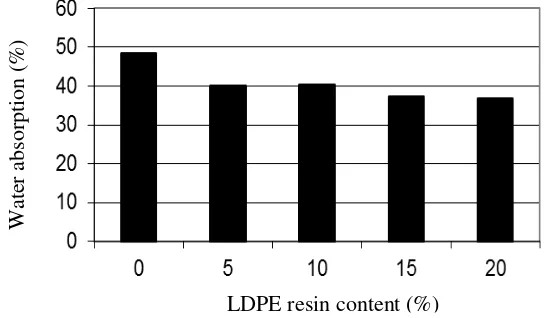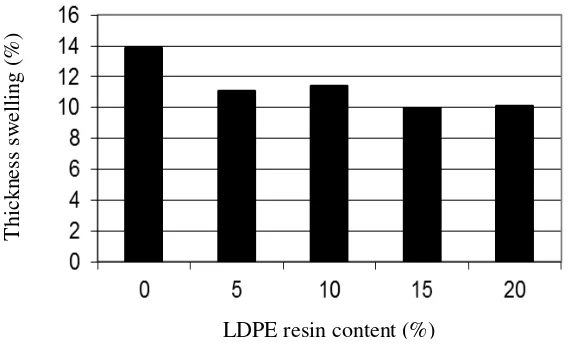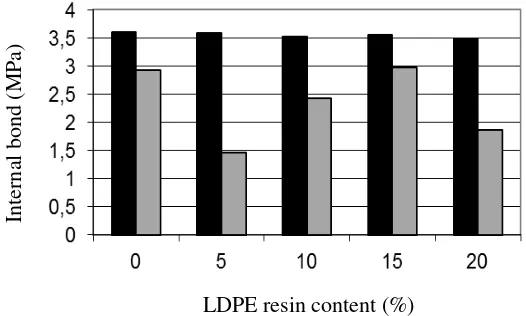See discussions, stats, and author profiles for this publication at: https://www.researchgate.net/publication/273202857
Properties enhancement of rubber wood
particleboard laminated with low density
polyethylene (ldpe) resin
ARTICLE · JANUARY 2012
READS 15
3 AUTHORS, INCLUDING:
Fauzi Febrianto
Bogor Agricultural University
69PUBLICATIONS 71CITATIONS
SEE PROFILE
Properties Enhancement of Rubber Wood Particleboard Laminated
with Low Density Polyethylene (LDPE) Resin
Fauzi Febrianto1), See P Hwee2), Ching K Man2), Wahyu Hidayat3) 1)
Forest Products Department, Faculty of Forestry, Bogor Agricultural University, Bogor 16001, West Java, Indonesia.
2)
Department of Forest Production, Faculty of Forestry, University Putra Malaysia, 43400 UPM Serdang Selangor, Malaysia.
3)
Department of Forestry, Faculty of Agriculture, University of Lampung, Bandar Lampung, Indonesia
Corresponding author: [email protected] (Fauzi Febrianto)
Abstract
The main weaknesses of particleboard are that it has a lower strength and a lower dimensional stability compared to solid wood. Therefore, in order to gain excellent properties prior to be used, it needs some treatments, i.e., resin thermoplastic laminated. The objectives of this study were to improve the physical and mechanical properties of rubber wood particleboard laminated with low density ethylene (LDPE) resin. Rubber wood particleboard was laminated with 4 different concentrations of LDPE resins (i.e., 5, 10, 15, and 20%). The physical and mechanical properties of board were evaluated both in dry and wet states. The results indicated that the dimensional stability of board after laminated with LDPE resin showed significant improvement in term of water absorption and thickness swelling. Modulus of rupture and srew resistant of resulted particle board were increased with addition of LDPE resin. Modulus of elasticity and surface hardness of the particleboard were slightly decreased with addition of LDPE resin. The intenal bond was unchanged. The best treatment was found on lamination the surface of particleboard with 5% LDPE resin. All the physical and mechanical properties of particleboard laminated with 5% LDPE resin met the requirements of JIS A 5908-2003 standard.
Key words: dimensional stabilization, low density polyethylene, mechanical properties, particleboard
Introduction
Particleboard is a generic term for a panel manufactured from lignocellulosic materials (usually wood), primarily in the form of discrete pieces or particles, as distinguished from fibers, combined with a synthetic resin or other suitable binder and bonded together under heat and pressure in a hot press by a process in which the entire inter particle bond is created by the added binder, and to which other materials may have been
Properties Enhancement of Rubber Wood Particleboard Laminated with Low Density 187 The main uses of particleboards are as
floor deck, floor underlay, siding, stair tread, door shelving etc. However, particleboards also have their own weaknesses in comparison with solid wood i.e. it has low dimensional stability Particleboard has a thickness swelling rate of around 10-25% from dry to wet condition, and linear swelling rates up to 0.35% (Haygreen & Bowyer 1996). Thus, particleboard is not suitable as building materials for exterior and in humid condition application. The strength of particleboard belongs to mediocre.
It has been noted that addition small amount paraffin only can result in slightly improvement of particleboard dimensional stability, but the strength of the particleboard is unchanged (Maloney 1993). Another solution to improve both dimensional stability and strength of particleboard can be achieved through laminating particleboard with resin (i.e., thermoplastic resin). High density polyethylene (HDPE), low density polyethylene (LDPE), polyethylene (PE), polypropylene (PP) and polystyrene (PS) belong to polyolefins (Harper 2002). They are commonly used as matrices in developing wood plastic composites products (Febrianto et al. 2005). Hence, in this study laminating rubberwood particleboard with various amount of LDPE resin was conducted to improve the physical and mechanical properties of rubberwood particleboard.
Materials and Methods
Materials
Commercial rubberwood particleboard was obtained from Hevea board Factory at Gemas, Negeri Sembilan Malaysia. Resin LDPE in the form of granules was purchased from plastic factory at
Segamat, Johor, Malaysia. The main equipment used were hot and cold pressing machine, Universal testing machine (UTM), digital balance, aluminium foil, oven, and water bath.
Laminating rubberwood particleboard with LDPE resin
Various amount of LDPE resin i.e., 0, 5, 10, 15, and 20% based on rubberwood particleboard oven dried (OD) weight were poured onto both surfaces of samples. The samples were then hot-pressed at 175 ºC at 17 kgf cm-2 for 6 min. After hot pressing, the samples were then conditioned for 1 week at room temperature prior to be tested. Each test was performed in 3 replicates.
Evaluation of physical and mechanical properties
Evaluations of physical and mechanical properties of particleboard were done both in dry and wet conditions. The test was carried out based on the JIS A5908-2003 (JSA A5908-2003). Density, moisture content (MC), water absorption (WA), thickness swelling (TS), modulus of rupture (MOR), modulus of elasticity MOE), internal bond (IB), screw resistant (SR), and surface hardness (SH) parameters were evaluated.
Data analysis
Statistical analysis system/SAS software with the ANOVA method was used to determine the effect of various amount of LDPE resins on the physical and mechanical properties of particleboard laminated with LDPE resin.
Results and Discussion
Physical properties
MC, WA, and TS after immersing in density were found on particleboard laminated with 20% LDPE resin and control particleboard, repectively. The higher the amount of LDPE resin used to laminate the rubberwood particleboard tend to result in greater the density. However, statistical analysis showed that density of particle board was not affected by addition various amount of LDPE resin. JIS A 5908 standard stated that the density of commercial particleboard should be in the range of 0.4-0.9 g cm-3. All the density of rubberwood particleboard laminated with various amount LDPE resin met the requirement of JIS A 5908-2003 standard.
Figure 2 exhibited the MC of rubberwood particleboard laminated with various amount of LDPE resin. The value of MC was in the range of 3.42-7.70%. The highest and the lowest values of MC were found on control particle board and particleboard laminated with 20% LDPE resin, repectively. Laminated rubberwood with LDPE resin significantly decreased the MC value. It was found that the higher LDPE resin added resulted in the lower the MC value. When the boards were laminated with LDPE resin, it formed hydrophobic sheet on the board’s surface and restricted the board to absorb the water vapor. Hence, the value of MC decreased. JIS A 5908-2003 standard stated that the MC of commercial particleboard should be in the range of 5-13%.All the MC of rubberwood
particleboard laminated with various amount LDPE resin met the requirement of JIS A 5908-2003 standard.
The average value of WA of board after immersing in cold water for 24 h was particle board and particleboard laminated with 20% LDPE resin, repectively. Similar trend was found with MC. The WA values of particleboard were much affected by addition various amount of LDPE resin. The higher the amount of LDPE resin was laminated on board’s surface resulted in the lower the WA values. The average value of board’s TS after immersing in cold water for 24 h was presented in Figure 4. Addition of LDPE resin on the surface of rubberwood
particleboard decreased the board’s TS.
The values of board’s TS were found in the range of 9.90-13.85%. The highest and the lowest values of TS were found on control particle board and particleboard laminated with 15% LDPE resin, repectively.
Statistical analysis showed that the TS values of particle board were much affected by addition various amount of LDPE resin. Due to LDPE resin was hydrophobic in nature, lamination the surface of board with LDPE resin formed hydrophobic layer on the board’s surface.
Properties Enhancement of Rubber Wood Particleboard Laminated with Low Density 189 Figure 1 Density (kg cm-3) of laminated rubberwood particleboard under various amounts of LDPE resin.
Figure 2 MC (%) of laminated rubberwood particleboard under various amounts of LDPE resin.
Figure 3 WA (%) of laminated rubberwood particleboard after immersing in cold water for 24 h under various amounts of LDPE resin.
LDPE resin content (%) LDPE resin content (%)
Moi
st
u
re c
ont
ent
(
%
)
Wa
ter
a
bso
rpt
ion
(%
)
LDPE resin content (%)
D
ens
it
y (
g c
m
Figure 4 TS (%) of laminated rubberwood particleboard after immersing in cold water for 24 h under various amounts of LDPE resin.
Similar results were reported by Anmalia (2003) when the particle board were laminated with polypropylene resin. JIS A 5908-2003 standard stated that the maximum value of commercial particleboard TS is 12%. All the TS of rubberwood particleboard laminated with various amount LDPE resin met the requirement of JIS A 5908-2003.
Based on the above results, it can be concluded that laminated rubberwood particleboard with LDPE resin greatly
improved board’s dimensional
stabilization. The best treatment was achieved on the board laminated with 15% LDPE resin. The WA and TS values of boards laminated with LDPE resin obtained in this experiment were much better compared with the values showed on JIS A 5908-2003 standard.
Mechanical properties
Mechanical properties of laminated rubberwood particleboard i.e. MOR, MOE, IB, SR, and SH parameters under various amounts of LDPE resin both in dry and wet states were evaluated. The average values of those parameters were presented in Figures 5, 6, 7, 8, and 9.
Figure 5 exhibited the average MOR values of rubberwood particleboard laminated with various amount of LDPE resin. The values of MOR were in the range of 26.58-31.25 and 18.53-28.80 MPa, respectively for dry and wet states. The highest and the lowest values of MOR in dry state were found on particleboard laminated with 20% LDPE resin and control particleboard, repectively. The highest and the lowest values of MOR in wet state were found on particleboard laminated with 15% LDPE resin and control particleboard, repectively. The MOR values of particleboard both in dry and wet states were influenced by various amount of LDPE resin addition.
Statistical analysis showed that the MOR values of particle board were much affected by addition various amount of LDPE resin. It is clear that the higher the amount of LDPE resin used to laminate the board surfaces resulted in the greater the value of MOR both in dry and wet states. The best treatment was achieved on the board laminated with 20% LDPE resin.
Thic
kn
es
s
sw
el
li
ng (
%
)
Properties Enhancement of Rubber Wood Particleboard Laminated with Low Density 191 Figure 5 MOR (MPa) of laminated rubberwood particleboard under various amounts of LDPE resin( : dry state; : wet state).
Figure 6 MOE (MPa) of laminated rubberwood particleboard under various amounts of LDPE resin( : dry state; : wet state).
Figure 7 IB (kg cm-2) of laminated rubberwood particleboard under various amounts of LDPE resin ( : dry state; : wet state).
LDPE resin content (%)
LDPE resin content (%) LDPE resin content (%)
Modu
lus o
f r
u
pt
u
re
(MPa
)
Int
er
na
l b
o
nd (
MPa
)
Modu
lus o
f e
la
st
ic
it
y
(M
P
The average values of MOE of laminated rubberwood particleboard under various amounts of LDPE resin were presented in Figure 6. The values of MOE were in the range of 4477-5659 and 2211-2328 MPa, respectively for dry and wet states. The highest and the lowest values of MOE in dry condition were found on control particleboard and particleboard laminated with 20% LDPE resin. With or without lamination the surface of particleboard with LDPE resin, the MOE of particleboard in wet state showed state. Statistical analysis showed that the MOE values of particle board were much affected by addition various amount of LDPE resin. It was reported that laminated particleboard using paint coating, wood veneer and plastic significantly improved the strength and stiffness properties of resulted board (Norvydas & Minelga 2006).
Figure 7 showed the average IB values of rubberwood particleboard laminated with various amount of LDPE resins. The value of IB was in the range of 3.49-3.59 and 1.45-2.98 MPa, respectively in dry and wet states. The highest and the lowest values of IB in wet state were found on control particleboard and particleboard laminated with 5% LDPE resin. Laminating the surface of board with LDPE resin did not significantly affected the IB value in dry state.
Figure 8 showed the average SR values of rubberwood particleboard laminated with various amount of LDPE resin. The values of IB were in the range of
35.17-46.15 and 17.63-36.67 MPa, respectively for dry and wet states. The highest and the lowest values of SR in dry state were found on particleboard laminated with 5 and 20% LDPE resin, and he highest and the lowest values of SR in wet state were found on particleboard laminated with 10 and 15% LDPE resin, repectively.
Laminating the surface of board with LDPE in various amounts of LDPE resin significantly affected the SR values. Laminating the surface of board with LDPE resin slightly decreased the SR values. The higher the amount of LDPE resin was used to laminate the board resulted in the lower the value of SR, particularly in dry state.
Figure 9 showed the average SH values of rubberwood particleboard laminated with various amount of LDPE resin. The value of SH was in the range of 455.83-700.38 and 244.97-389.00 kgf, respectively for dry and wet conditions. The highest and the lowest values of SH in dry state were found on the control of particleboard and particleboard laminated with 20% LDPE resin. Furthermore, the highest and the lowest values of SH in wet condition were found on the particleboard laminated with 10 and 20% LDPE resin, respectively. Laminating the surface of board with LDPE resin significantly reduced the SH of board. The higher the amount of LDPE resin was used to laminate the board tend to result in the lower the value of SH, both in dry and wet states.
Based on the results, it can be concluded that laminated rubberwood particleboard with LDPE resin improved the
performance of board’s in term of MOR
Properties Enhancement of Rubber Wood Particleboard Laminated with Low Density 193 Figure 8 SR (kg) of laminated rubberwood particleboard under various amounts of LDPE resin ( : dry state; : wet state).
Figure 9 SH (kgf) of laminated rubberwood particleboard under various amounts of LDPE resin( : dry state; : wet state).
However, these values still met the requirements of JIS A 5908-2003 standard.
Conclusion
Based on the above results, it can be concluded that laminating the surface of rubber wood particleboard with LDPE
resin improved the dimensional stability (i.e. moisture content. water absorption and thickness swelling), and some mechanical properties (i.e. MOR and SR) and reduced some mechanical properties (i.e. MOE, and SH) of the particleboard. The IB parameter in dry state was unchanged. The best treatment was lamination the surface of particleboard
LDPE resin content (%)
Surf
ace
h
ar
dn
es
s
(kg
f)
LDPE resin content (%)
Scr
ew r
es
ist
anc
e (
k
with 5% LDPE resin. All the physical and mechanical properties of particleboard laminated with 5% LDPE resin met JIS A 5908-2003 standard.
References
Anmalia EF. 2003. Peningkatan kualitas papan partikel kayu sengon (Paraserianthe falcataria): Sifat fisis dan mekanis papan partikel yang dilapisi dengan plastic polipropilena daur ulang dengan dan tanpa compatibilizer [Skripsi]. Bogor: Fakultas Kehutanan IPB.
Febrianto F, Setyawati D, Karina M, Bakar ES, Hadi YS. 2005. Influence of wood flour and modifier content on the physical and mechanical properties of wood flour-polypropylene composites. J Biol. Sci. 6(2):337-343
Harper CA. 2002. Handbook of Plastics, Elastomer and Composites. New York: McGraw-Hill.
Haygreen JG, Bowyer JL. 1996. Hasil Hutan dan Ilmu Kayu: Suatu Pengantar. Sutjipto AH: penerjemah. Yogyakarta: Gajah Mada University Press. Terjemahan dari: Forest Product and Wood Science: An Introduction.
[JSA] Japanese Standard Association. 2003. Particleboards JIS A 5908. Tokyo: Japanese Standard Association.
Maloney TM. 1993. Modern
Particleboard and Dry Process Fiberboard Manufacturing. San Francisco: Miller Freeman Inc.
Norvydas V, Minelga D. 2006. Strength and stiffness properties of furniture panels covered with different coatings. Material Sci. 12(4):328-332.
Riwayat naskah (article history)



